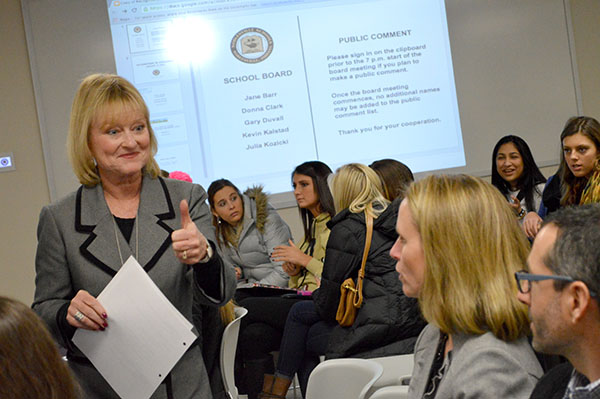Q & A: Superintendent weighs in

Photo by Photo by S. Enders
Superintendent Beth Niedermeyer circles the room before the school board meeting conversing among the audience.
January 23, 2015
Superintendent Beth Niedermeyer was appointed on July of 2014 and has just finished her first semester filled with budget cuts and school board meetings. Looking back, Niedermeyer reflects on challenges and anticipates future decisions.
Q: What have been some of the reactions to not changing the school start times next year?
Niedermeyer: This was a tough decision that required careful thought and study. With any decision I would have made regarding start times, some people would have been disappointed. While certainly that has been the case with my decision to keep the start times the same, I have also heard from those who support the decision and appreciated and understood my rationale.
Personally, I believe the research that shows later start times are beneficial for adolescents. However, I felt that making a change in start times was not a good decision at this time because of the strong feelings voiced by our community: a significant portion of our community did not support the change, felt district leadership wasn’t listening to them, felt we were implementing changes too rapidly, and that we were not focused on change in the right areas.
Q: What things do you take into account when looking at whether to have a two hour delay/closing or not?
Niedermeyer: Typically decisions to delay are based on factors such as allowing more time for road crews to clear roads, waiting for daylight to help buses and cars see students standing in roads if bus stops are not cleared from snow, giving buses more time to warm up and deal with any mechanical issues that may arise due to cold temperatures, checking the accuracy of weather forecasts because they do not always materialize as originally predicted. In some cases, a couple of hours can make a difference with temperatures warming.
Decisions to close are based on factors such as, roads being impassable, buses not running, county/state weather emergencies or road closures.
Our staff drives the roads in Noblesville to make assessments before a decision is made. We also use the National Weather Service wind chill chart to study temperatures/wind chills and length of time allowed outside before frostbite is a risk.
Q: What days can we expect to use as make up days?
Niedermeyer: We don’t know what the weather will bring and if that will create more closures or not. We have another flex day on February 16th that we’ll use if there is a weather-related school cancellation prior to that date. There is also a flex day on June 4th if needed.
Q: Are there any big changes you plan on making to the 2015/2016 school year?
Niedermeyer: The strategic planning to accommodate the growth in Noblesville will be a focus for the 2015-16 school year as will our continued work to engage, inspire and empower our students in their learning and success in college, careers, and life.
Q: What has been the greatest challenge during your time as the superintendent?
Niedermeyer: There are always challenges to any leadership role. One challenge I addressed in the first semester was the budget trimming which was necessary to ensure the continued financial health of the organization. It is important to note that we were able to do that without impacting funding to classrooms and teachers, and without anyone losing their employment.
Q: Since the millstreams audience is primarily students, I would like to know what you are doing to make sure you are listening and responding to the opinions of the student body and how well you think you are doing it?
Niedermeyer: My staff helps keep me informed at a high level about significant student concerns, and my monthly Table Talk at Noble Coffee and Tea is open to students. Making time for this interview could be another example of my communication with students. I am always willing to listen to ideas and opinions students would like to share with me.


